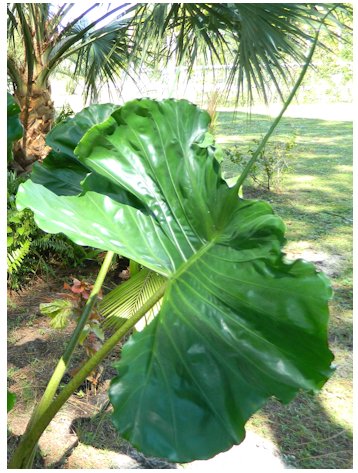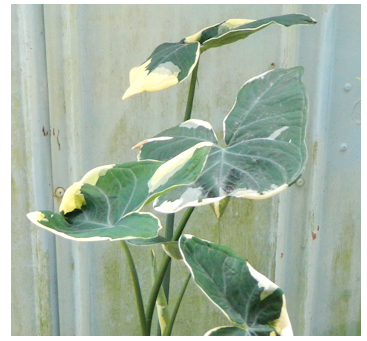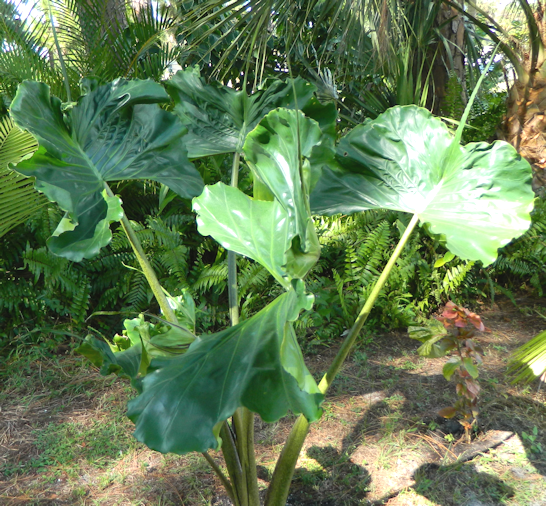 Alocasia, the stingray plant, or Stingray Elephant's Ear, is easy to grow and definitely a conversation plant. If you are lucky enough to live in agricultural zone 10B, you will never have to worry about this plant dying back from frost, and can place it in the ground without protection. Zones 9 though 10A will have to protect it from light frosts, by mulching the base and throwing a cloth
sheet over the top of it on those few cold nights. Zone 9 people may lose the top growth, but the mulching will save the tubers and if watered regularly, they will shoot back up in spring and rebound with full growth.
Alocasia, the stingray plant, or Stingray Elephant's Ear, is easy to grow and definitely a conversation plant. If you are lucky enough to live in agricultural zone 10B, you will never have to worry about this plant dying back from frost, and can place it in the ground without protection. Zones 9 though 10A will have to protect it from light frosts, by mulching the base and throwing a cloth
sheet over the top of it on those few cold nights. Zone 9 people may lose the top growth, but the mulching will save the tubers and if watered regularly, they will shoot back up in spring and rebound with full growth.
Stingray Elephant Ears require dappled sunlight, or light sun exposure. Too much direct sun will burn them, although I have seen a few where gardeners have been able to defy logic and place in a more sunny location. In these cases, the plant is watered more frequently. Placing it out in a large, deeply dug bed enriched with loam, coir or peat, perlite, and compost will give your Stingray plant it's best chance at success.
 Alocasia Stingrays can grow to very large heights, like their cousins, the regular Elephant Ears. Mine are currently 6 feet tall, and I've heard of them even taller.
Some websites claim this plant does not grow but to only 3 feet or so. Untrue. It's a large plant when able to grow out without the threat of frost.
Alocasia Stingrays can grow to very large heights, like their cousins, the regular Elephant Ears. Mine are currently 6 feet tall, and I've heard of them even taller.
Some websites claim this plant does not grow but to only 3 feet or so. Untrue. It's a large plant when able to grow out without the threat of frost.
There is even a variegated version similar to the Stingray plant, called Alocasia Cucullata, with a bubbly lip and a thinner, more thread-like 'stinger'. It is hard to see the stinger in my photograph, but trust me, it's there. On Alocasia Cucullata, the leaf is complete, unlike the true Stingray plant.
Water both of these species of Alocasia plants only moderately. I learned the hard way they do not care for water near as much as their cousin, the Giant Elephant Ears, or Tarrow plants, who actually sit in boggy waters. Instead, let the top couple of inches of the soil dry out a bit before watering it again. Do not over fertilize this plant either. Instead, put time released fertilizer pellets on it if in the landscape, and re-apply every 3 months throughout the growing season. If it is potted, feed it a 10-10-10 liquid solution every other month from Spring through Fall, and then let it rest in the Winter.

A Polynesian native, the Stingray Elephant Ear is in the Araceae family. In it's native habitat, it lives underneath the huge canopies of the larger trees, spreading in large clumps through underground tubers. You can propagate it in the same fashion, by first allowing it to spread, and then dig up a few of the tubers, or offshoots, and replant them elesewhere in your garden or pot them up.
The Stingray Elephant Ear pictured above was placed in the ground. Beforehand, my husband dug a 3 foot wide by 2 foot deep hole, and we filled it with the same soiless mix we use on our brugmansia. It has thrived. If you do place it in the landscape, keep it moist for about 2 weeks, and then taper off on the watering. The plant will soon begin to establish itself, and take to the earth.
The Stingray Elephant Ear seems to be an easy to care for, elegant garden or potted plant with little attention paid to it. I hope you add one to your own collection soon, you will love the comments you receive from visiting friends.
Tags: care and grow alocasia stingray plant, care and grow alocasia stingray plant, stingray plant, grow Elephant Ear Stingray Plant,

